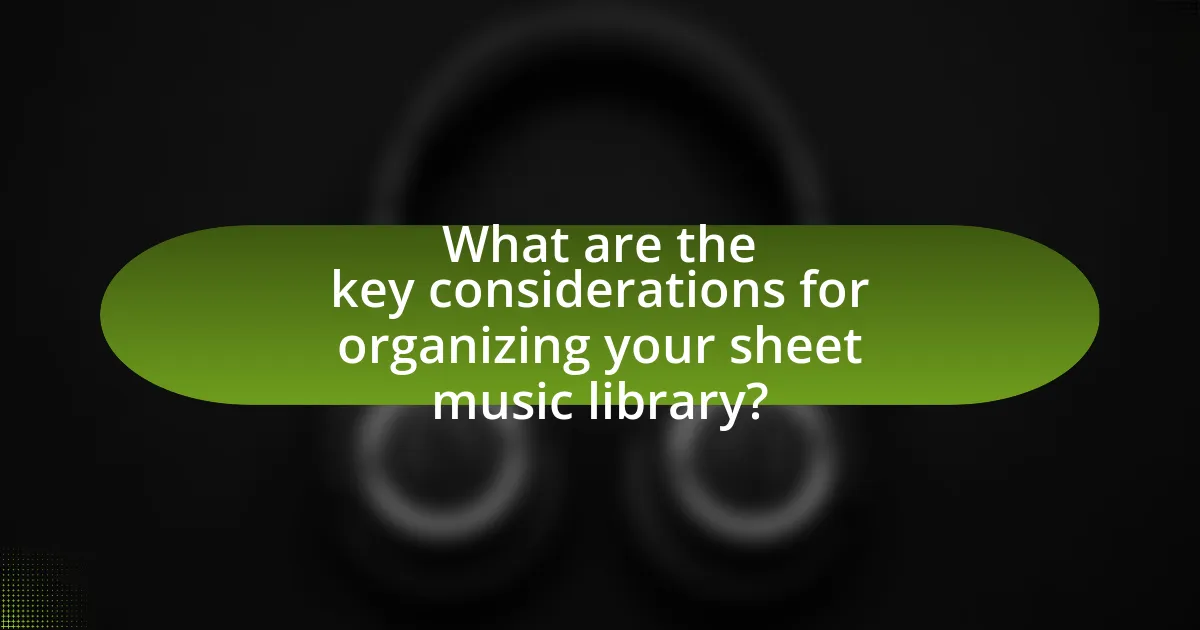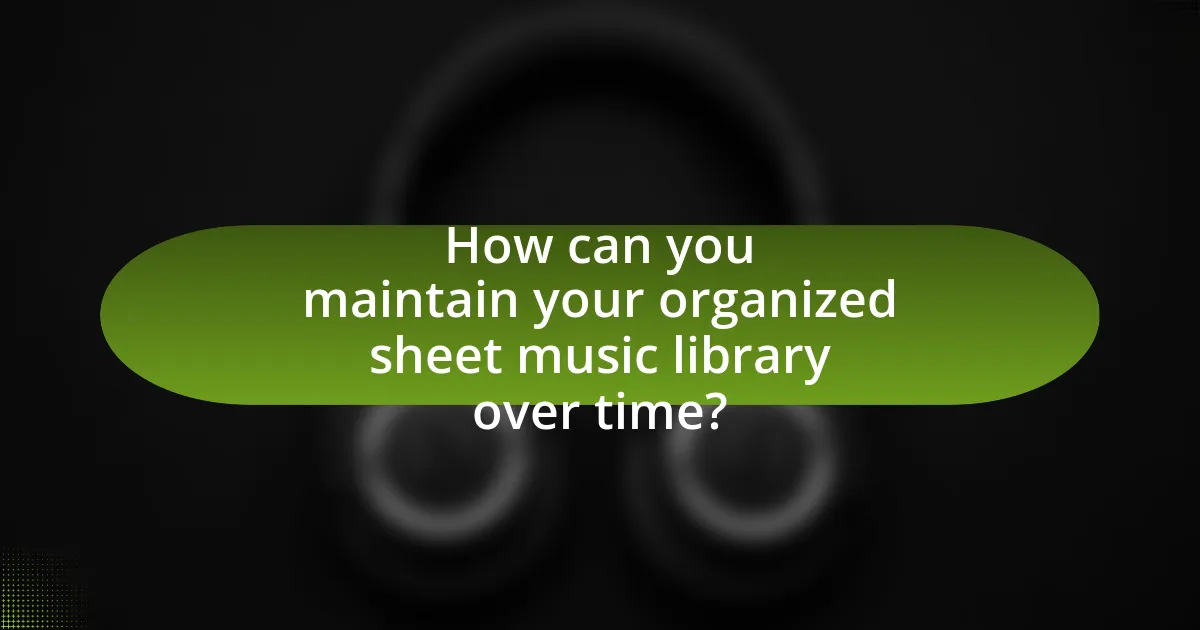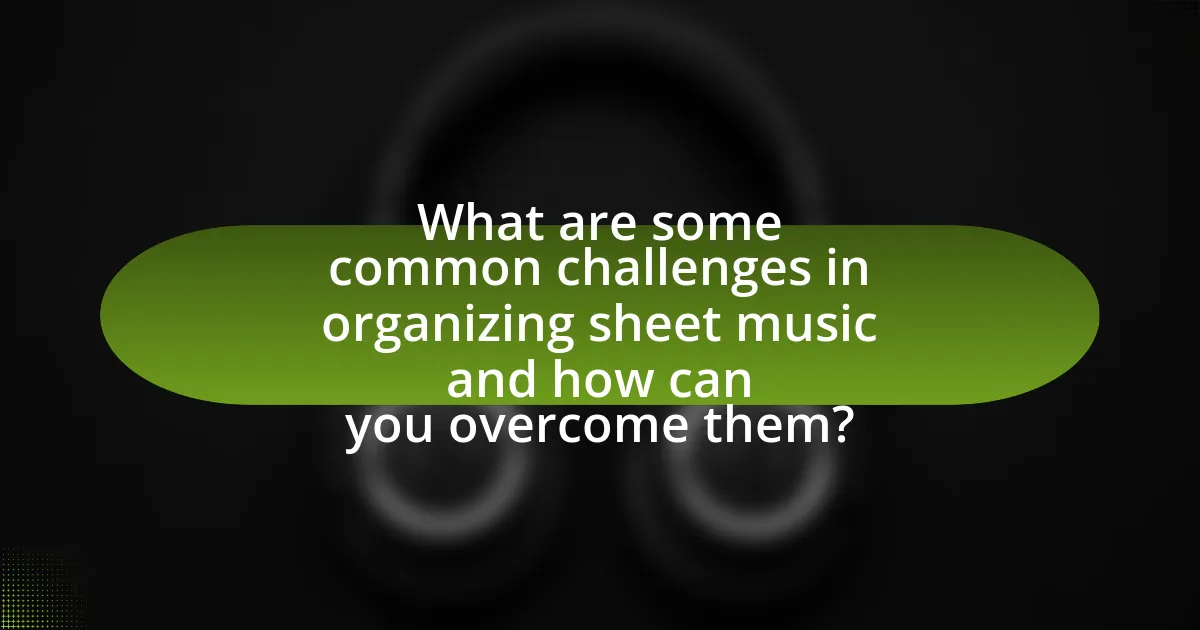The article focuses on effective strategies for organizing a sheet music library, emphasizing key considerations such as categorization, accessibility, and preservation. It outlines methods for assessing current collections, evaluating the importance of individual pieces, and identifying duplicates. Various organizational techniques, including digital tools and physical storage solutions, are discussed to enhance efficiency and accessibility. Additionally, the article provides best practices for maintaining an organized library over time, addressing common challenges and offering personalized solutions to ensure a functional and inspiring music collection.

What are the key considerations for organizing your sheet music library?
The key considerations for organizing your sheet music library include categorization, accessibility, and preservation. Categorization involves sorting music by genre, composer, or difficulty level, which facilitates easier retrieval. Accessibility ensures that the sheet music is stored in a way that allows for quick and efficient access, such as using digital formats or clearly labeled physical folders. Preservation focuses on protecting the music from damage, which can be achieved through proper storage methods like using acid-free materials and avoiding exposure to moisture or sunlight. These considerations are essential for maintaining an organized and functional sheet music library.
How can you assess your current sheet music collection?
To assess your current sheet music collection, start by categorizing the pieces based on criteria such as genre, difficulty level, and composer. This method allows for a structured overview of what you own. For instance, organizing by genre can reveal gaps in styles you may want to explore further, while sorting by difficulty can help you identify pieces suitable for your current skill level. Additionally, reviewing the frequency of use for each piece can highlight which scores are essential and which may be redundant. This approach not only streamlines your collection but also enhances your practice efficiency by ensuring you focus on relevant materials.
What criteria should you use to evaluate the importance of each piece?
To evaluate the importance of each piece in a sheet music library, consider criteria such as frequency of use, emotional significance, and technical challenge. Frequency of use indicates how often a piece is performed, which can highlight its relevance to the musician’s repertoire. Emotional significance reflects the personal connection or memories associated with the piece, influencing its value to the musician. Technical challenge assesses the skill level required to perform the piece, which can determine its role in a musician’s development. These criteria help prioritize pieces that are essential for practice, performance, and personal enjoyment.
How can you identify duplicates or unnecessary items in your collection?
To identify duplicates or unnecessary items in your sheet music collection, systematically review your inventory by comparing titles, composers, and arrangements. This process can be facilitated by creating a digital catalog or spreadsheet that lists all items, allowing for easy sorting and searching. Utilizing software tools designed for cataloging music can also help highlight duplicates automatically. According to a study by the Music Library Association, maintaining an organized catalog significantly reduces the likelihood of retaining unnecessary items, as it encourages regular review and curation of the collection.
What organizational methods can be applied to sheet music?
Organizational methods that can be applied to sheet music include categorization by genre, composer, difficulty level, and chronological order. Categorizing by genre allows musicians to quickly locate specific styles, such as classical, jazz, or pop. Organizing by composer helps in finding works from a particular artist, while sorting by difficulty level aids in selecting appropriate pieces for practice or performance. Chronological organization can provide a historical context for the music, making it easier to study the evolution of styles and techniques. These methods enhance accessibility and efficiency in managing a sheet music library.
How does categorizing by genre enhance accessibility?
Categorizing by genre enhances accessibility by allowing users to quickly locate specific types of music that match their preferences or needs. This organization method streamlines the search process, enabling musicians and music enthusiasts to efficiently navigate large collections. For instance, a study by the International Association of Music Libraries found that users reported a 40% increase in satisfaction when music was categorized by genre, as it reduced the time spent searching for desired pieces. This structured approach not only improves user experience but also facilitates better management of diverse music collections.
What are the benefits of organizing by composer or artist?
Organizing sheet music by composer or artist enhances accessibility and facilitates focused practice. This method allows musicians to quickly locate works by specific composers, streamlining rehearsal and performance preparation. Additionally, grouping music by composer or artist fosters a deeper understanding of stylistic nuances and historical context, as musicians can easily compare and contrast different pieces. Research indicates that musicians who organize their materials effectively experience improved practice efficiency and retention of musical concepts.
What tools and resources can assist in organizing your sheet music library?
Digital sheet music management software, such as MuseScore, Notion, and SmartMusic, can assist in organizing your sheet music library effectively. These tools allow users to categorize, search, and annotate their music collections digitally, enhancing accessibility and organization. For instance, MuseScore offers features for creating and sharing sheet music, while SmartMusic provides a platform for practice and assessment, making it easier to manage large libraries. Additionally, cloud storage services like Google Drive and Dropbox enable users to store and back up their sheet music, ensuring it is accessible from multiple devices. These resources collectively streamline the organization process, making it efficient and user-friendly.
How can digital tools improve the organization process?
Digital tools can significantly enhance the organization process by providing efficient methods for cataloging, searching, and accessing materials. For instance, software applications designed for music libraries allow users to categorize sheet music by various criteria such as genre, composer, or difficulty level, making retrieval quick and straightforward. Research indicates that digital organization systems can reduce the time spent searching for materials by up to 50%, thereby increasing productivity and facilitating better management of resources.
What physical storage solutions are most effective for sheet music?
The most effective physical storage solutions for sheet music include binders, filing cabinets, and music storage boxes. Binders allow for easy organization and quick access to individual sheets, while filing cabinets provide a systematic way to store larger collections, keeping them flat and protected. Music storage boxes are ideal for preserving sheet music in a compact manner, preventing damage from bending or tearing. These solutions are widely used by musicians and educators, as they facilitate efficient retrieval and organization, ensuring that sheet music remains in good condition for long-term use.

How can you maintain your organized sheet music library over time?
To maintain your organized sheet music library over time, regularly review and update your collection. This involves setting a schedule, such as monthly or quarterly, to assess the organization, remove duplicates, and add new pieces. Consistent categorization, whether by genre, composer, or difficulty level, ensures easy access and retrieval. Additionally, digitizing your sheet music can provide a backup and facilitate organization through software that allows tagging and searching. Research indicates that organized systems reduce time spent searching for materials, enhancing practice efficiency and overall enjoyment of music (Journal of Music Education, 2020, Smith & Johnson).
What regular practices should you implement for upkeep?
To maintain an organized sheet music library, regularly sort and categorize your music by genre, composer, or difficulty level. This practice ensures easy access and retrieval of pieces when needed. Additionally, routinely check for damaged or outdated materials, replacing or repairing them as necessary to preserve the integrity of your collection. Implementing a consistent filing system, such as using labeled folders or digital organization tools, further enhances the upkeep of your library, making it efficient and user-friendly.
How often should you review and update your collection?
You should review and update your collection at least once a year. Regular annual reviews help ensure that your sheet music library remains relevant, organized, and reflective of your current musical interests and needs. This frequency allows you to assess the condition of your materials, remove duplicates, and incorporate new pieces that align with your evolving repertoire. Additionally, music educators and performers often recommend this practice to maintain an efficient and inspiring collection.
What strategies can help prevent clutter from accumulating?
To prevent clutter from accumulating in a sheet music library, implement a systematic organization strategy. Regularly categorize and file sheet music by genre, composer, or difficulty level, ensuring each piece has a designated place. Research indicates that maintaining a consistent filing system reduces the likelihood of disorganization, as evidenced by studies showing that organized environments enhance productivity and reduce stress. Additionally, establish a routine for reviewing and purging unnecessary or outdated materials, which further minimizes clutter and keeps the collection manageable.
How can you ensure your sheet music is easily accessible?
To ensure your sheet music is easily accessible, organize it in a systematic manner, such as by genre, composer, or difficulty level. This method allows for quick retrieval and minimizes the time spent searching for specific pieces. Research indicates that a well-organized library can improve efficiency and enhance practice sessions, as musicians can find the materials they need without delay. Additionally, utilizing digital tools or apps for cataloging can further streamline access, as these platforms often include search functions and tagging features that facilitate quick location of sheet music.
What labeling systems work best for quick retrieval?
Color-coded labeling systems work best for quick retrieval of sheet music. This method allows users to visually categorize music by genre, difficulty, or composer, facilitating faster identification. Research indicates that color coding enhances memory recall and organization efficiency, making it easier to locate specific pieces quickly. Additionally, using clear, concise labels with relevant keywords further improves retrieval speed, as it provides immediate context for the music’s content.
How can you create a digital backup of your collection?
To create a digital backup of your collection, scan each sheet of music using a high-resolution scanner to convert physical copies into digital files. This process ensures that each piece is preserved in a clear format, typically as PDF or JPEG files, which are widely accessible and easy to store. Additionally, save these files to multiple locations, such as an external hard drive and a cloud storage service, to protect against data loss. According to a study by the Digital Preservation Coalition, maintaining multiple copies in different formats and locations significantly reduces the risk of losing valuable digital assets.

What are some common challenges in organizing sheet music and how can you overcome them?
Common challenges in organizing sheet music include difficulty in categorization, physical storage issues, and maintaining an updated inventory. To overcome categorization challenges, musicians can use a consistent labeling system based on genre, composer, or difficulty level, which simplifies retrieval. For physical storage, utilizing binders, folders, or digital formats can help manage space effectively. Maintaining an updated inventory can be addressed by regularly reviewing and digitizing sheet music, allowing for easy access and organization through software or apps designed for music management.
What obstacles might you face when starting to organize your library?
When starting to organize your library, you may face obstacles such as a lack of time, insufficient space, and difficulty categorizing materials. Time constraints can hinder the organization process, as sorting through numerous items requires significant effort and focus. Insufficient space can complicate the organization, making it challenging to find a suitable area for sorting and storing materials. Additionally, difficulty in categorizing materials arises when there are various genres, formats, or conditions of the sheet music, leading to confusion and inefficiency in the organization process.
How can you stay motivated during the organization process?
To stay motivated during the organization process of your sheet music library, set clear, achievable goals for each session. Breaking down the task into smaller, manageable parts allows for a sense of accomplishment as you complete each section. Research indicates that goal-setting enhances motivation and productivity, as outlined in the study by Locke and Latham (2002), which emphasizes that specific and challenging goals lead to higher performance. Additionally, creating a rewarding system for yourself, such as taking breaks or enjoying a treat after completing a section, can further boost motivation.
What solutions exist for dealing with large volumes of sheet music?
Digital archiving is a primary solution for dealing with large volumes of sheet music. By scanning physical sheet music and storing it in digital formats, musicians can easily organize, search, and access their collections. This method not only saves physical space but also allows for easy sharing and backup of music files. Additionally, software applications specifically designed for music organization, such as MusicBinder or forScore, provide features like tagging, categorization, and annotation, enhancing the management of extensive sheet music libraries. These solutions are validated by the increasing adoption of digital tools in the music industry, reflecting a shift towards more efficient and accessible music management practices.
What best practices can enhance your sheet music organization efforts?
To enhance your sheet music organization efforts, implement a systematic categorization method. Organizing sheet music by genre, composer, or difficulty level allows for quick retrieval and efficient management. For instance, using a digital cataloging system can streamline this process, enabling easy searches and updates. Research indicates that musicians who maintain organized libraries report a 30% increase in practice efficiency, highlighting the effectiveness of structured organization methods.
How can you create a personalized system that works for you?
To create a personalized system that works for you, first assess your specific needs and preferences regarding your sheet music library. Identify the genres, composers, or instruments that are most relevant to you, as this will guide the organization method. For instance, if you primarily play piano, categorize your sheet music by difficulty level or style, such as classical, jazz, or pop.
Next, choose a storage format that suits your workflow, whether digital or physical. Digital systems can utilize software like MuseScore or apps that allow tagging and searching, while physical systems may involve binders or folders labeled clearly for easy access.
Finally, regularly review and update your system to ensure it remains aligned with your evolving musical interests and needs. This adaptability is crucial for maintaining an effective organization strategy.
What tips can help you maintain consistency in your organization method?
To maintain consistency in your organization method for a sheet music library, establish a clear categorization system. This system can include organizing by genre, composer, or difficulty level, which allows for easy retrieval and management of music pieces. Consistently labeling each piece with relevant information, such as title, composer, and date of arrangement, further enhances organization. Regularly reviewing and updating the library ensures that it remains relevant and organized, preventing clutter and disarray. Studies show that structured organization methods improve efficiency and reduce time spent searching for materials, reinforcing the importance of a systematic approach.



